#dalia kheer
Photo

Dalia Kheer Recipe | Mastercook | Broken Wheat Payasam
The greatest way to end a meal is with a traditional Indian dessert prepared by Mastercook Dalia! It is made with milk, almonds, nuts & a smidgeon of cardamom.
Visit - https://mastercookfoods.com/recipe/
0 notes
Note
Dude I got Kheer from a new place and I'm so disappointed. It's soup. Sweet soup with rice and cardamom. That is not what I was craving.
oh no,,,,,, wait should i give you a recipe? kheer can be made with a lot of different ingredients - my mom makes it with either rice, sevaiyaan (vermicelli), sabudana (tapioca sago according to the internet), bottle gourd or dalia (wheat with the husk). rice kheer is not sweet soup it has this like thick texture and usually a lot of dry fruits (raisins, cashews, almonds, etc). i am sorry you had to experience that.
2 notes
·
View notes
Text
How to prepare a Oats Dalia Kheer recipe
Method
Roast 1 cup ‘Jiwa Oats Dalia’ in 1 tbsp Ghee till you can smell heaven in your kitchen.
Pressure cook the Dalia with 3 cups water for 3 whistles.
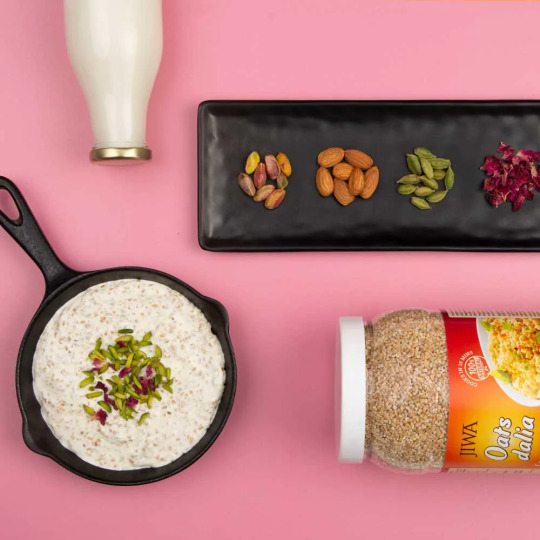
Click here to know more about Oats Dalia Kheer recipe
0 notes
Text
youtube
Broken Wheat Kheer | Godi Kadi Payasa | Godhuma Rava Payasam | Dalia Kheer | Broken Wheat Payasam
0 notes
Text
Broken Wheat Pudding Recipe, Nutrition Fat & 20 Healthy Benefits of Broke
Broken Wheat Pudding Recipe, Nutrition Fat & 20 Healthy Benefits of Broke
About broken wheat pudding
Broken Wheat Halwa is a healthy Indian dessert. This pudding or kheer is commonly eaten as a dessert in India and is very popular in the northern part of the Indian country. Broken whey pudding is usually served as a dessert on the occasion of marriage or celebration.
Some of my friends have asked me, “Is it possible to eat delicious and healthy sweets at the same…

View On WordPress
#amazing recipe#benefits of broken wheat#benefits of crack wheat#benefits of lapsi#Broken Wheat kheer#Broken wheat pudding#bulgar wheat#bulgar wheat pudding#bulgar whet benefits#crack wheat#crack wheat benefits#dalia#dalia benefits#dalia kheer#dessert recipe#easy sweet dish recipe#healthy and tasty recipe#healthy recipe#lapsi#lapsi kheer#lapsi pudding#north recipe#nutrient of broken wheat#quick and easy recipe#recipe for kids#recipes#recipes tip#sweet recipe#tasty recipe#wheat recipe
0 notes
Text
What is Unani Medicine?
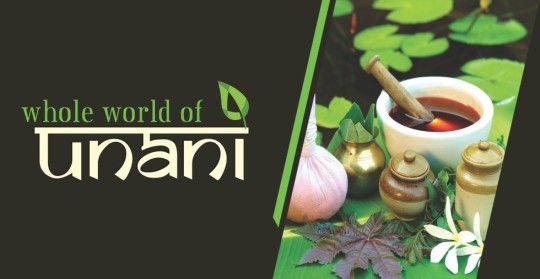
"Unani medicine is a system of alternative medicine that originated in ancient Greece but is now practiced primarily in India. Involving the use of herbal remedies, dietary practices, and alternative therapies, Unani medicine addresses the prevention and treatment of disease."
Unani (UNANI TIBB - Greco-Arabic Medicine) is the Arabic word for Ionian, or Greek. Greece's Islamic neighbors call Greece Yunanistan, or the Land of the Unanis. While Western Europe was in the Dark Ages, Greek Medicine and other branches of classical science and learning found a safe haven in Islamic lands. But Greek Medicine didn't remain static or unchanging; it continued to grow and evelve as Muslim scholars and physicians continued to make important discoveries and contributions of their own.
In the process, Greek Medicine was "Islamicized" into Unani-Tibb, or Greco-Arabic Medicine. This transformation proved that Greek Medicine was flexible, resilient and adaptable enough to absorb and incorporate new developments and influences. Within a few short centuries after its birth, the Islamic world had expanded to stretch from the Atlantic ocean in the west to the Indian ocean in the east, from Moorish Spain to the plains of Hindustan.
Everywhere the Muslims went, their Unani physicians went with them, adapting themselves to the local conditions and resources. In the words of Unani medical historians, Unani Tibb enriched itself by imbibing new medicines, techniques and treatments from the various cultures and medical systems with which it came into contact, which included Indian Ayurveda and Oriental Medicine.
Around the time of the Crusades, the Islamic world produced a few very prominent and influential physicians and medical scholars. Their names were Latinized, and their medical treatises were imported into Europe and translated into Latin, to serve as texts and reference manuals in the medical schools that were just starting to spring up in Medieval Europe. Ibn Rushd, or Averroes
(1120 - 1198) was a physician and Islamic scholar and philosopher in Moorish Spain.
He wrote a five volume treatise on medicine called Al-Culliyat (The Fundamentals), or Colliget. Al-Razi, or Rhazes (865 - 924) was a Persian physician, chemist and alchemist. He wrote a vast medical encyclopedia called Continens, with many excerpts from Hindu and Greek medical sources.
But the greatest of these was undoubtedly "Hakim Ibn Sina", or "Avicenna". He wrote a five volume treatise called The Canon of Medicine, which became a standard textbook in European medical schools. Today, it serves as the basic handbook for all practitioners of Unani Medicine.
Unani Medicine found fertile soil in India. The Delhi Sultanate and later the Moghul emperors were great patrons of medicine. Many eminent physicians from Persia and Central Asia came to India not only to seek fame and fortune, but also to find a safe haven from the wars and strife devastating their homelands.
Under British rule, all forms of healing except conventional allopathic medicine were discouraged. But Unani Medicine survived, due to its popularity with the masses, and the safe, gentle yet effective nature of its treatments. Hakim Ajmal Khan (1864 - 1927) was an Unani physician, and also an Indian patriot and freedom fighter in the struggle for independence. He was also a great advocate and champion of the indigenous systems of Ayurvedic and Unani Medicine, and pioneered scientific research into their treatments.
Relationship Between Tabiyat and Asbab-e-Sittah Zarooriah
In the Unani system of medicine, tabiyat is an individual’s internal power or capacity to withstand or combat disease and to perform normal physiological functions. Believing that it is only tabiyat that is engaged in actually curing a disease, Unani hakims hold that they only assist from “outside” by prescribing therapeutic relief. If not adversely affected, tabiyat can eradicate most infections without medical treatment, using what may be thought of as the natural defense system of the mind and body.
Unani medicine recognizes six physical, or external, factors, called asbab-e-sittah-zarooriah, which are essential in establishing a synchronized biological rhythm and thus living a balanced existence.
The Six Asbab-e-Sittah-Zarooriah Are:
1. Hawa (air), in which the quality of the air a person breathes is thought to have a direct effect on his or her temperament and, thus, health.
2. Makool-wo-mashroob (food and drink), in which the nutritional value and the quality and quantity of one’sfood and drink are believed to ensure physical fitness by strengthening tabiyat.
3. Harkat-wo-sakoon-e-jismiah (bodily exercise and repose), which emphasizes the positive effects of balanced physical exercise on an individual’s internal resistance and tabiyat.
4. Harkat-o-sakoon nafsaniah (mental work and rest), which emphasizes the simultaneous engagement of the human mind in numerous emotional and intellectual activities. Just as the body needs systematic and planned exercise
and rest, Unani medicine holds that the human mind and brain need adequate stimulation and proper relaxation as well.
5. Naum-o-yaqzah (sleep and wakefulness), in which an individual’s health and alertness are understood as being dependent on a specific amount of sound sleep in the course of a 24-hour (circadian) cycle.
6. Ihtebas and istifragh (retention and excretion), which considers the metabolism of food and liquid as both affecting and being regulated by tabiyat. According to Unani medicine, the assimilation of food andliquid facilitates the elimination from the body of excessive and noxious substances. Therefore, to maintain a harmonic and synchronized tabiyat, certain beneficial end-products of kaun-o-fasad (genesis and lysis) are retained in the body while harmful ones are expelled.
These six factors are believed by Unani practitioners to directly affect the harmony of the human mind and body. Socioeconomic, geographic, and environmental factors are considered secondary factors (asbab-e-ghair
-zarooriah) in the Unani system and therefore indirectly influence tabiyat. However, both the primary and the secondary factors must be closely considered in the Unani process of treatment.
Modes Of Treatment
The initial approach to treatment in the Unani system entails the establishment of a regimen to normalize and balance the external factors (e.g., air, water, and food) involved in ailments and diseases. If this proves inadequate, then other means, such as treatment with natural medicines, may be recommended. Any
Unani treatment prescribed by a hakim acts as an outside agent to help boost the patient’s tabiyat and thus restore good health and a sense of well-being.
There are various therapeutic approaches available to the hakim. Ilaj-bi-ghiza, or diet therapy, involves recommending a specific diet, which is the simplest and most natural course of treatment by a hakim. For fever, for example, Unani medicine stresses a nutrient-rich, low-roughage diet that might include dalia
(porridge) and kheer (a milk broth). Both the amount and quality of food are taken into consideration. Relatively infrequent in modern Unani Therapy is ilaj-bi-misla, or organotherapy, a mode of treatment that involves healing a diseased organ with the use of tissue extracts from the same organ of a healthy animal.
Ilaj-bi-dawa, or pharmacotherapy, is the use of medicines by Unani hakims. This treatment method is considered by hakims to be natural, eco-friendly, and less intrusive and more effective than many other methods. The Unani system’s pharmacopoeia is vast, enriched with more than 2,000 medicines derived from various herbal, mineral, and animal sources. Unani medications are often processed by classical methods of preparation as originally described in Greco-Arabic medicine. Unani medicines are used singly or are compounded with other substances to achieve synergistic, antagonistic, or detoxifying effects or simply as bases for effective ingestion and assimilation.
In the 1920′s Indian physician Ajmal Khan revolutionized Unani medicine by advocating that research be conducted on various natural products that were claimed by ancient physicians to effect miraculous cures. In the 1930′s
Indian-born scientist Salimuzzaman Siddiqui, who specialized in phytochemistry (the chemistry of plants), isolated potent constituents from a plant known in India as chhota chand (Rauwolfia serpentina). Subsequent pharmacological research determined that the plant was the source of a bio-active substance known as reserpine, which found use in Western medicine as a tranquilizer and as an anti hypertensive agent (lowering abnormally high blood pressure). Those uses supported some of the medical applications that had been described by hakims.
Siddiqui named the derived medicines, which included ajmaline and ajmalicine, for Khan as a tribute to his groundbreaking research efforts.
Having gained recognition from the World Health Organization (WHO) in 1976, the Unani system became increasingly accepted internationally as a system of traditional medicine. In India several institutions engaged in Unani teaching and research. The Central Council for Research in Unani Medicine (CCRUM), an undertaking of the Indian government, for instance, facilitated the translation of classical heritage, the organization of clinical trials, the improvement of drug standardization, and the investigation of toxicological and phytopharmacological properties of natural products that had long been used by hakims.
Classical Unani medicine recommended established “regimental” therapies (tadabeer) in the treatment of various chronic and acute diseases. Those therapies include dalak (massage), hammam (bath and sauna), karat (exercise),
fasd (venesection, or opening a vein to let out blood), hijamat (cupping, a process of drawing blood to the surface of the body by using a glass cup or tube), and amat-e-kai (leeching, or bleeding a person by using leeches). The essential function of all those regimens is to remove impure blood or impurities from the body.Surgical interventions, or ilaj-bil-yad, are a last resort. Their practice generally is beyond the realm of the hakim’s expertise.
Obstacles In Unani Medicine
Although a complete system of treatment, the Unani system, similar to other systems of medicine, has drawbacks in terms of application and effectiveness. The vast materia medica, from herbal and animal to mineral sources, as described in ancient Unani textbooks, is sometimes so vague that authenticity must be established by modern pharmacognostic assessments (by means of a basic, descriptive pharmacology) before medicines can be put to use. In addition, the use in Unani medicine of precious stones and minerals, the chief ingredients of many polyformulations (medicines containing multiple ingredients), is expensive. Those items often are unavailable as well, thereby
hindering effective treatment.
Intense research is important for the use of kushta, the incinerated finely powdered substance prepared from known toxic metals, such as seemab (mercury), sam al-far (arsenic), sangraf (mercuric chloride), and khubs al-hadid (iron rust). Medicines made with those minerals, when used with caution and expertise, may be effective, but they have significant toxic side effects.
Today, the Indian government supports and subsidizes both Ayurvedic and Unani medical colleges and hospitals. But whereas Ayurveda has enjoyed a phenomenal surge in popularity, Unani Medicine still lags behind in recognition, perhaps due to its minority Islamic associations.
The SOLIAIR™ company regularly developed various blends and plant extracts that show promise and positive healing results in treating many illnesses and medical symptoms from a wide variety of diseases that are currently existing in this world. The SOLIAIR™ Food supplements are patented and are regularly been used by doctors, pharmacists and patients in Israel and around the world! - Please Contact Us for a professional advice and treatment!
Best Regards,
Solomon J.
(Naturopath/Alternative Therapist)
#####
youtube
#unani medicine#unani therapies#unani health#unani practices#alternative medicine#alternative therapies#alternative health#naturopathy#phytotherapy#homeopathy#herbs#medicinal herbs#natural health#plant extracts#natural medicine#complementary medicine#complementary therapies#ayurvedic medicine#chinese medicine#natural cures#medicinal plants#herbal medicine#botanical medicine#phytopharmaceuticals#anti aging#naturopathy treatment#unani therapist#homeopathy medicine#homeopathy practices#naturopathy practices
1 note
·
View note
Text
Looking for a healthy meal for everyday craving?
The delicious bowl of Insta Dalia Kheer of fespro is grained with whole wheat, sorghum and corn and the rich garnish of almond and cardamom.
If you are an insane lover of kheer, this Sweet breakfast will divinely interest you!

0 notes
Text
Dalia Payasam | Cracked Wheat Kheer
Dalia Payasam | Cracked Wheat Kheer
Dalia payasam is a traditional sweet dish from Karnataka. It is rich in nutrients and a good food for people of all ages.
What is Dalia ?
Dalia is broken wheat grain, it is made from the whole grain. It is used in cooking different kind of dishes as upma, pulav, payasam and porridge.
What are the other names by which it is known?
Daliya is commonly known as broken wheat or cracked wheat. In…

View On WordPress
0 notes
Photo

Here is something 👇👇👇new , I tried my hands on ,which my lil girl loved eating!! . . A healthy,Instant Breakfast Bucketwheat( Dalia) with Oats Milk(Vanilla) ,Dry Seeds and fresh fruits🙂🙂that can be served in warm or cold😍😍 . . . @Urbanplatter.in has introduced plant based milk in 3 variants - Classic ,Vanilla and Rich Cocoa . Options to try out: 🌾Filter coffee / Cutting Chai or Cappuccino 🌾Kheer / Payassam 🌾Breakfast Cereals 🌾Vegan Ice creams #preschoolerplay#oatwow #veganmilk, #veganproducts,#plant-based, #veganrecipes,#urbanplatter, #plantmilk,#oatmilkrecipe , #Indianoatbreakkfastrecipes, #kidsfoodtideas #Healthyfood #healthy #food #foodbloggers #instagram #foodinstagram #breakfast #Indianbreakfast #fruits #superhealthy #kidseatingwhole #eatingwell #indianfoodrecipes #indianfood #eatgoodfeelgood #foodphotography (at Home Sweet Home....DehraDun) https://www.instagram.com/p/CEEDD7TBFMC/?igshid=1vry7j62bhr3z
#preschoolerplay#oatwow#veganmilk#veganproducts#plant#veganrecipes#urbanplatter#plantmilk#oatmilkrecipe#indianoatbreakkfastrecipes#kidsfoodtideas#healthyfood#healthy#food#foodbloggers#instagram#foodinstagram#breakfast#indianbreakfast#fruits#superhealthy#kidseatingwhole#eatingwell#indianfoodrecipes#indianfood#eatgoodfeelgood#foodphotography
0 notes
Text
MASALA MILK POWDER: ADD TASTE TO YOUR MILK❤
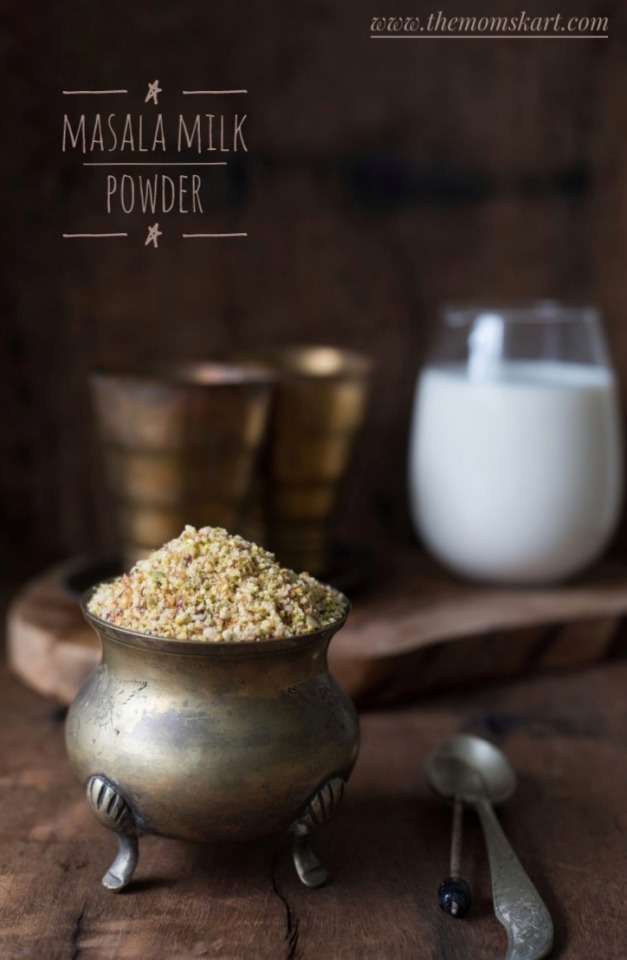
Children to their mom : I don't like milk, its smells yuck!!! .
Mom: Drink my child it will make you strong . Wait! There is a solution to your problem why don't we add masala milk powder 😍😋 to your drink ??
Children: wooh! It seems yummy Mom.
As we were in school, mom would give us Haldi doodh (hot turmeric milk) in the mornings and a cold or warm beverage of masala milk (depending on the season) in the evenings or nights. Well, milk was a compulsory drink in our home. As it is nutritious for our health and it can be consumed by anyone in the family.
Masala doodh powder is a fragrant healthy powder that is added to milk, made with dry fruits and a few fragrant spices.
Doodh Masala is an blend of nuts and spices ground to a coarse to fine powder and used to flavor the milk. One of the most traditional way of flavoring the milk is adding some sweet spices to it. families have their own recipe to this blend and there can be additions or deductions to the list of ingredients. The Doodh Masala is my most preferred add-on to the milk. I also go ahead and add it to my Dalia or Oats when I have them for breakfast with milk. A cup of masala milk before bed time helps in enjoying a good night’s sleep.
The Doodh Masalo makes a versatile blend that comes handy while making other desserts like kheer, kulfi or various halwa. Instead of assembling all the different nuts just add the required quantity of this blend to the dessert.
Go ahead and make your own blend of Doodh no Masala!! Oh yes, make sure to use fresh dry fruits.

We can't forget this delicious taste of masala milk . Why don't you try this amazing homemade masala powder for your cravings.
As momskart sell this item online on
www.themomskart.com
The best E-commerce site for your everyday cravings .All types of Indian sweets, Indian Snacks, Indian spices, Indian pickles etc are available for you .Order anytime All India Delivery. Three layered packaging. Contactless Delivery. No minimum order.
So , start to shop from this amazing Homemade Masala powder by Indians Mothers 🥰

0 notes
Text
HOW TO AVOID MONOTONOUS INTAKE OF FOODS

Consuming same type of food brings about monotony in life this is because we consume almost similar foods following similar cooking procedures. This deprives us of various new tastes which we fail to explore. Since heart patients are advised to avoid certain food stuffs it is better to have variety of food so that it can be followed for a long time. Given below is an example of various combinations that one can follow and plan one's menu.
SEVEN DAYS FEAST
Planning is an important aspect in human life. Somehow, till now we have ignored it as in terms of our daily eating habits. Unknowingly, we keep on repeating the same menu day after day. To make our everyday eating a more pleasurable experience, try SAAOL Seven Day Menu for a week. (If suitable, can be continued for long with some modification as per individuals likes and dislikes).
Monday Tuesday Wednesday Thursday Friday Saturday Sunday
Skimmed milk Rava Idli with Vegetable Missi roti with Oat meal/ Pav
Stuffed roti, 1 cup with tomato chutney, Sandwiches mint coriander Cracked wheat bhaji
Low fat yogurt, cornflakes, Suji upma, any Macaroni chutney, Water porridge (Dalia) poha,
Sliced Banana toasted bread seasonal whole Fruit Shake melon/any Egg whites, whole
and apple, with jam, fruit, SAAOL seasonal fruit Fresh fruits fruit,
SAAOL Tea Green/Black Tea SAAOL
grapes Tea
Raitas: Anar raita / Grapes-cucumber raita /Spinach-bathua raita / Pineapple raita / Mixed vegetable raita / Sweetned yogurt / Mint raita
Dessert: Fresh Fruit custard/ Jelly / Sevai / Rice Kheer / Stewed fruit. Raitas and Desserts or any other milk preparation can be included in the daily menu after adjusting the recommended allowance of skimmed milk (200 ml).
RECIPE FOR A HAPPY YEAR
Step one: Take 12 complete months. Clean them carefully of all bitterness, hate and envy. Cut each month into 29, 30 or 31 pieces, but do not cook them all at the same times.
Step two: Prepare one day at a time, with the following ingredients: a pinch of a faith, a pinch of patience, a pinch of courage and pinch of work. Add to each day one part hope, faithfulness and kindness.
Step three: Mix well with one part prayer, one part medication and one part application.
Step four: Season with a portion of good spirits, a pinch of happiness, a little action and a good measure of humor.
Step five: Place everything in a vessel of love.
Step six: Cook well on the fire of radiant happiness.
Step seven: Garnish with a smile and serve abundantly.
HEART FRIENDLY FOODS
Oats: High in fiber, low in fat, sodium-free and a good source of complex carbohydrates, they contain more protein than any other major grain. During the 1980s, oats, and oat brain in particular, was touted as the magic bullet to vanquish cholesterol and save hearts. In the 1990s, the mighty FDA has finally sent down word that indeed, a diet rich in oatmeal can go a long way toward protecting a healthy heart. best of all, this natural "health" food can be enjoyed in a multitude of dishes, because unlike many other grains, you can dress it up, cook it in a variety of dishes.
Sprouts: Sprouts are beneficial to the heart. They not only are a good source of Vitamin E but also are rich in Vitamin B-complex, calcium and iron. Since they contain lot of moisture they increase the bulk of food and thus help in reducing weight. They can be taken in breakfast as such or as fillings in variuos sprout based recipes.
Garlic: Garlic has been used since the days of Egyptians to treat wounds, infections, tumors and intestinal parasites. The more garlic people eat the lower their risk of heart disease. Garlic has a great impact on improving the elasticity of the aorta, main artery in the blood. Garlic's sulphur containing compounds lower cholesterol by stimulating the release of bile by the gall bladder and by reducing the production of cholesterol in the liver. In addition, garlic compounds gently lower blood pressure by slowing the production of the body's own blood pressure raising hormones.
Wheat Bran: Also known as choker, it is the roughage, which is present in the wheat. Choker is fiber and if mixed with flour reduces its calorie content besides having the benefits of fiber.
How to Reduce Calories
* Stuffing chapatis with vegetables like potato, cauliflower, cabbage, radish, palak, methi, green peas.
* Stuffing chapati with chokar.
* Take plenty of soups.
* Salads/fruits before food and between foods.
* Drink a glass of water before meals.
* Use of equal, sugarfree, sweetex in place of sugar and jaggery.
* Juices in plenty whenever you are hungry.
* Rice with huge amount of vegetables.
Hope you liked this blog!
This blog is written by Dr. Bimal Chhajer (Heart Doctor New Delhi)

0 notes
Photo

Popular Broken Wheat Daliya Recipe
Broken Wheat Daliya is a most popular North India dish with whole wheat grits made either as a sweet dalia kheer or as savoury daliya. Get this popular dish recipe online at Golden Bansi.
#broken wheat#broken wheat daliya#daliya#upma#semolina#durum wheat semolina#durum wheat semolina supplier#sooji manufacturers in india
0 notes
Text
Dalia Kheer

We prepared Dalia khichuri, as dinner time.It’s so boring ! Why not prepared Dalia Kheer with plum jaggery/Khgur gurer dalia payes.

Dalia kheer,prepared easy.I used raisin,ghee,fat free milk.Kheer is delicious flavour.I used plum jaggery,it’s good for health.

Before that I prepared variety type of kheer.This is the frist time I prepared Dalia kheer,it’s awesome.

Let’s start the procedure !
Pr…
View On WordPress
#bbcfood indianfoodblog#daliakheer#foodie#healthyrecipe#kolkatafoodblogger#lowcalorierecipe#smarthealthyrecipes#worldcidinerecipe
0 notes
Text
Simple Ways In Which Almonds Help To Lose Weight
During every festivity in India, exchanging boxes of dry fruits and nuts among friends and relatives is a tradition. But apart from just festive occasions, you should consider stacking up your kitchen cupboard with dry fruits and nuts especially almonds or badam. Almonds are one of the most sought-after tree nuts that come with an intensely dense nutritional profile. They are rich, delicious and crunchy.
Almonds have gained in popularity of late as a weight loss super food. Researchers have put forth many explanations as to how and why Almonds are helpful in making you slim and trim. Previously weight watchers used to keep almonds out of their diet thinking that the fat content in Almond could add to their existing fat reserves. But latest studies have flouted this stereotype and it’s indeed good news for nut lovers who are weight watchers too.
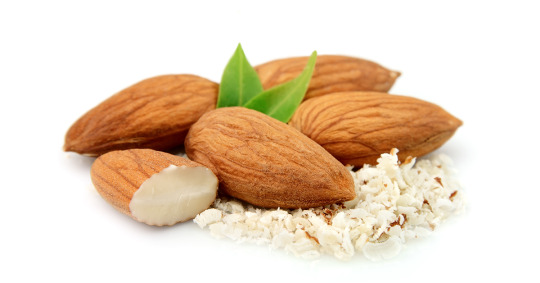
One Quarter Cup of Raw Almonds; i.e. 35 grams of Almonds per day is just enough to help you lose your extra pounds with ease. In a research published in Journal of Nutrition declared the same. If you are consuming almond butter, 1 tbsp of butter is just enough for a day’s consumption
Almonds can help you lose weight in the following ways:
Almonds are hunger-curbing
Almonds contain a decent amount of proteins (about 6 grams proteins in 1 ounce of almonds), fibers (about 3 grams fiber in 1 ounce of almonds) and healthy fats (about 15 grams fat in 1 ounce of almonds) and each of these contents cannot be digested easily. Slow digestion of the fats, proteins and fiber in Almond keeps you full for long and thus curbs your hunger and unhealthy eating habits.
Almonds improve metabolic rate
The high fiber content of Almonds improves your digestive power by cleansing your bowel efficiently. This helps you get rid of toxins from the body and by detoxifying your system, you can actually a big boost to your body’s metabolic rate fostering increased rate of fat burning.
Almonds can fuel your weight loss exercises
The high content of monosaturated fatty acids like Palmitoleic and Oleic Acids in Almonds can be helpful in supplying your body with all the needed energy. Energy is needed to perform the various weight loss exercises on regular basis and that helps you in the process of losing fat by increased rate of fat burning.
Almonds can keep blood glucose/sugar in check
The high fiber content of Almonds can help to stabilize blood glucose levels by checking sudden sugar spikes. This helps in weight management as no excess sugar is left in blood to be converted to body fat.
Almonds can make you consume lesser calories
According to research, not all of the calories in Almonds are absorbed by the body. Researchers opine that almonds may contain 30 percent lesser calories than mentioned in the nutritional labels. The reason is that the cell structure of Almonds is rigid enough to allow full absorption of the entire calorific content of Almonds.
Almonds support your weight loss efforts
Almonds are rich in nutrients such as Copper, Magnesium and Vitamin E. This rich nutritional profile helps you in your weight loss journey. Weight loss consists in cutting down on calories and going on a weight loss diet. Weight loss diet will limit your total calorie intake. This may make you deficient in certain nutrients. Taking almonds will never allow you to go deficient in vital nutrients and this will support your weight loss endeavors efficiently.
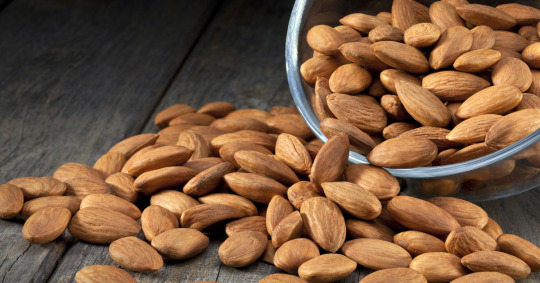
If you wish to incorporate almonds in your weight loss diet, you can do it in the following ways:
1.If you are trying to lose weight through Almonds, you can use the Almonds either raw or roasted or in the form of Almond Milk or Almond Butter or Almond Powder.
2.To prepare roasted almond, you need to heat skillet over low flame and then dry roast the almonds. If you want you can sprinkle some salt to get roasted salted almond or can drizzle the roasted almonds with honey to get roasted honey almonds.
3.If you want to make Almond Powder, you need to first soak almonds in water, remove the skin and dry roast the almonds. Once roasted, you can put the almonds in a grinder and grind almonds into a coarse powder.
4.If you want to prepare Almond milk, you have to grind almond along with water in a food processor. Next you need to squeeze out the milk by making the water-almond mix pass through a muslin cloth potli.
5.If you want to prepare Almond butter at home, you need to process the dry roasted almonds for about 30 minutes in a food processor to get creamy, smooth and thick Almond butter.
6.Almonds can be used for weight loss effectively but are pretty high in calories (1 ounce of raw almonds contain 162 calories). So, you have to keep in mind the portion size or else you’ll end up de-railing your weight loss efforts. The best way to keep track of the Almonds portions is to use a scale initially until you get experienced enough to understand the right portions for weight loss even without measuring.
7. Also, make sure to use the right kind of Almonds. It is best for you to go for the lowest calorie Almond options such as raw almonds (1 ounce= 162 calories) instead of the dry roasted almonds (1 ounce=167 calories) or honey roasted almonds (1 ounce=166 calories) or oil roasted ones (1 ounce=170 calories)
8. However, if you are planning to consume raw almonds, it’s always wise on your part to consume soaked raw almonds rather than the dry raw almonds. By soaking almonds you can boost the nutrients availability factor of Almonds. Raw almonds come with a tough brown outer skin that contains an enzyme inhibitor protecting the nuts until germination. This enzyme inhibitor does not allow proper absorption of nutrients by the human body. But if Almonds are soaked overnight, the moisture removes the enzyme inhibitor and the nutrients are made available to your body easily.
9. You can add chopped almonds or almond powder to dalia kheer, puddings, sharbats, cereals, smoothies, salads etc. Also, you can add almond powder to flour while preparing the dough for roti/chappatis.
10. Thus these mini delights in the form of Almonds can make a healthy weight loss snack. So, make sure to stash almonds in your bag whenever you are going out. These meaty, crunchy nuts will stop you from unhealthy binging habits and will help you stick to your weight loss regime most zealously.
0 notes